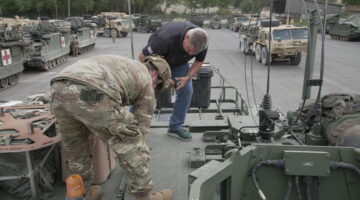
WASHINGTON — The Navy awarded Lockheed Martin a $62 million contract modification for one-time engineering work and studies “in support of identifying” how the company’s widely-used cargo plane can be made suitable for the E-XX TACAMO program.
E-XX TACAMO is the Navy’s next-generation plane that in times of crisis would be responsible for relaying orders from the president to the crews of submarines carrying nuclear weapons. The service in late 2020 selected Lockheed’s C-130J-30 to be the core of the next-generation nuclear command, control and communications aircraft.
“The Analysis of Alternatives results indicated that the four-engine, militarized C-130J-30 is optimally configured aircraft for performing the TACAMO mission. The characteristics of this airframe also maximize the operational deployability of the assets to austere environments,” Naval Air Systems Command, the agency primarily charged with purchasing Navy aircraft, wrote in a publicly available notice at the time.
Thursday’s contract award, however, indicates there’s still work to be done to ensure the C-130J-30 is the right plane. The Pentagon announced the contract award in its routine daily announcements.
“This modification increases a contract line item to provide for rapid execution of non-recurring engineering, to include studies, engineering analysis, airframe analysis, and risk reduction of the C-130J-30 aircraft in support of identifying if the aircraft can meet E-XX capability requirements and the changes that will be required to the aircraft,” according to the announcement.
Lockheed deferred Breaking Defense’s request for comment about the award to the Navy. Naval Air Systems Command did not respond by press time.
Breaking Defense reported earlier this month that two industry teams are forming up to compete in the Navy’s pending competition to outfit the E-XX TACAMO aircraft, which will also feature a Very Low Frequency subsystem built by Collins Aerospace. The VLF is a key system necessary for the plane to communicate with submarines regardless of their submerged depth.
One team will be led by Northrop Grumman, which has recruited a business unit from both Raytheon and Lockheed Martin’s Skunk Works to join it. On another team is Collins Aerospace, who is a Raytheon subsidiary, and which has recruited the privately-owned aerospace firm Sierra Nevada Corp. to join it.
Raytheon competing on both teams — its Intel and Space segment is teamed with Northrop, while its subsidiary Collins Aerospace leads an opposing team — is a common practice in defense contracting and reflects the value some companies place on winning work within certain programs.
The nuclear command, control and communications (NC3) mission has for several years been identified by Pentagon leaders as a top priority. The president’s new budget request seeks more than $37 billion for nuclear modernization, including NC3.
In the budget request, the Navy projects it will purchase the first three E-XX TACAMOs in fiscal 2027 and another six in FY28. The request is also seeking $214 million in research and development funding in FY24 for the E-XX TACAMO program.

